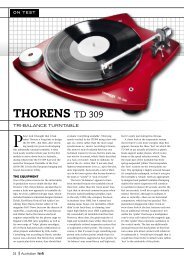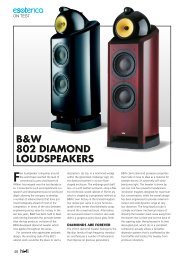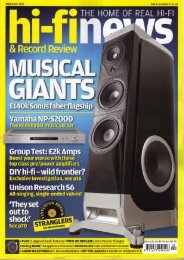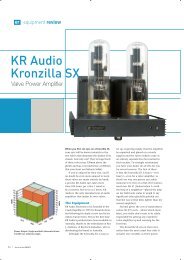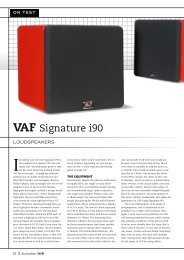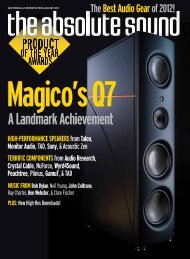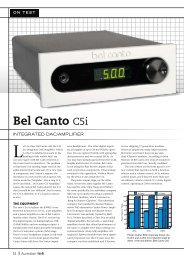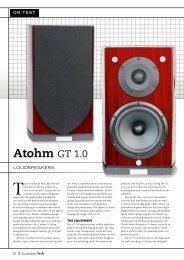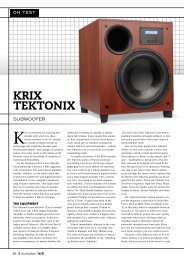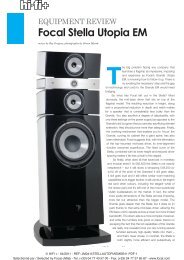here - Ultra High-End Audio and Home Theater Review
here - Ultra High-End Audio and Home Theater Review
here - Ultra High-End Audio and Home Theater Review
- No tags were found...
You also want an ePaper? Increase the reach of your titles
YUMPU automatically turns print PDFs into web optimized ePapers that Google loves.
n one sense, this review is easy to write. The Venture Gr<strong>and</strong>Ultimate is a superb speaker system that does everythingextremely well. At another level, however, it presents a majorchallenge: The Gr<strong>and</strong> Ultimate costs nearly $90,000 a pair. Forsome audiophiles, this raises serious questions as to just howexpensive high-end gear should get. More broadly, it imposes adifferent st<strong>and</strong>ard for reviewing. At these prices, a speaker must bemore than excellent; it must challenge all other speakers in definingthe state of the art.Let me begin by addressing the cost issue. I can’t justify spendingnearly $90,000 on a speaker anymore than I can justify spendingequal or larger amounts of money for a car, a painting, a watch, orany other luxury item. I’m also all too well aware that the Gr<strong>and</strong>Ultimate is priced far beyond the spending capability of more than95% of the readers of this review—it is certainly priced far beyondmine, much as I wish that was not the case.TAS, however, is about absolutes, <strong>and</strong> finding the best at anyprice. It is a search that is in<strong>here</strong>ntly defined by extremes. Art <strong>and</strong>technology always advance by pushing to new limits. Moreover,we need such extremes to really be high-end audiophiles. We needspeakers <strong>and</strong> electronics that demonstrate just how good soundcan get. We need dealers <strong>and</strong> friends that provide a comparativelistening experience, <strong>and</strong> help us set the st<strong>and</strong>ards that allow usto judge the equipment we can afford. We need to know whatproducts are worth seeking out, <strong>and</strong> listening to, to help educateus as audiophiles.As for applying a higher critical st<strong>and</strong>ard to the Venture Gr<strong>and</strong>Ultimates, if you set prices that can only be justified by being thevery best, you really need to be the very best—particularly if youuse a name as gr<strong>and</strong>iose as “Gr<strong>and</strong> Ultimate.” Even if the priceweren’t so high, the name alone would provoke me into being asdem<strong>and</strong>ing as I possibly can be.The practical problem then becomes how to set such a higherst<strong>and</strong>ard <strong>and</strong> then describe how well the Gr<strong>and</strong> Ultimate can meetit. In an ideal world, this review would mean access to all of theworld’s best speakers, all at the same time. It would mean listeningto them under directly comparable conditions. The best I c<strong>and</strong>o is draw on acoustic memory <strong>and</strong> a limited range of listeningexperience to some of the best speakers with some of the bestassociated high-end equipment.Describing the result of my listening also presents problems.First, you quickly run out of credible adjectives to describe sonicnuances that are critical in justifying a speaker at this price. You canhear such nuances, but words can only take you part of the way in
communicating such an experience.You also are dealing with the law of diminishing returns. Anyexperienced audiophile knows, to his or her cost, that you paymore <strong>and</strong> more for smaller <strong>and</strong> smaller incremental improvementsin sound quality. You do not get a 45-fold increase in performanceby spending $90,000 on your speakers rather than $2000. T<strong>here</strong> isno meaningful way to quantify the level of improvement, but it hasgot to be far, far closer to 15%–20% than to 4500%. Hyperbole isone possibility, but it wears thin because it colors so much reviewingthat it has lost its impact. Being ruthlessly analytic is anotheranswer, but dangerous in a world w<strong>here</strong> almost every product isdescribed in superlatives <strong>and</strong> objectivity can be misinterpreted as asign the product does not approach the state of the art.So bear with me. I am going to try to explain why this is a speakeryou should consider if you have no effective limits on what youcan spend. I’m also going to try to explain why this is one of thosespeakers you should seek out for the kind of listening experiencethat will help you define your goals if—like me—you are limitedto far lower levels of investment. My words aren’t going to beenough, but hopefully, they will be an appetizer or incentive.Let me begin with the fact that this is an extraordinarily impressivedesign that reflects years of experimentation <strong>and</strong> effort. This is akey point in terms of pricing. You don’t pay these prices for costof manufacture, any more than you pay an artist for the cost of hismaterials <strong>and</strong> by the hour for his labor. You pay for the skill <strong>and</strong>taste of the designer—in this case, the importer, Mike Slaminski,tells me that he is Hoo Kong Njoo, known as Didi.Didi holds a Masters Degree in Physics from the University ofFrankfurt. He put his education to work at a research laboratorydoing investigations into cryogenics <strong>and</strong> super-conductor materials.According to the importer, the research was significant becausethe principal scientists were awarded a Nobel Prize for exemplarydiscoveries in super-conductivity. Didi then started a quest to design<strong>and</strong> fabricate “the most advanced speakers possible to realize theultimate in realism,” founding Venture <strong>Audio</strong> in 1986.At the same time, you can only underst<strong>and</strong> a product of thisquality <strong>and</strong> price if you underst<strong>and</strong> the design concepts behindit, <strong>and</strong> Venture supplies surprisingly little details about them in itsliterature. Fortunately, Mike Slaminski is one of those importers(Venture is made in Belgium) whose commitment to this speakerseems almost as deep as that of its designer, <strong>and</strong> provided the kindof detail I think is essential in describing a product this expensive.The Gr<strong>and</strong> Ultimates are not supersized compared to somespeakers in this price class, but they do weigh a solid 161 poundseach, <strong>and</strong> measure 13.8" x 19.7" x 48". Mike made it clear thatthe designer has been refining the use of multiple layers of solidhardwood to build up the outer walls of his speaker cabinets. TheGr<strong>and</strong> Ultimate has evolved out of this multiple-layer design, pluschanges made in an earlier Classic Series of speakers w<strong>here</strong> headded a heavy damping sheet in the middle of the solid beechwoodmulti-layers. Since that time, “Didi…discovered the advantage ofusing HDF (high-density fiberboard) layers in between the layersof solid hardwood. That later approach was used in the Gr<strong>and</strong>Ultimate cabinet with excellent results in reducing unwantedvibration.”I’ve worked with enough speaker designers over the years toknow this kind of enclosure effort is critical in exploring the stateof the art, <strong>and</strong> far from cheap. Moreover, the importer reportsthat “Didi has experimented with other methods of cabinetresonance control. The use of heavy materials, such as metal orgranite that have their own characteristic sound can induce a ‘cool’or ‘lifeless’ soundprint. As another example, the use of s<strong>and</strong> inthe speaker walls can result in a ‘dull’ soundprint.” In other words,these examples indicate that most cabinet designs have a way ofmanifesting peaks or valleys in the sound spectrum that complicate<strong>and</strong> compromise speaker design.“T<strong>here</strong> is another area of cabinet design that is important, <strong>and</strong>that is the shape of the cabinet. Didi uses a V-shape, w<strong>here</strong> linearbevels converge to a narrow front baffle, in order to minimize thebaffle surface area <strong>and</strong> the subsequent sound wave reflections.[The Gr<strong>and</strong> Ultimate uses] a similar cabinet shape, or C-shape,with continuous curves that converge to a narrow front bafflethat also minimizes baffle surface area. Baffle reflections interferewith the wavelaunch of the drivers, causing spurious distortionsof the sound <strong>and</strong> reducing the co<strong>here</strong>nce of the speaker…Once aquiet cabinet is achieved, the background is darker <strong>and</strong> the microdynamicsare preserved for superb focus of images <strong>and</strong> higherresolution of tones <strong>and</strong> sibilance.”Any photo of the result has to understate the resulting visualaesthetic—<strong>and</strong> yes, high-end design has to be judged visually aswell as by sound. The Gr<strong>and</strong> Ultimate is finished with a thicklayer of a hard polyester (circa 1300 microns thick), which furtherreduces cabinet vibrations. My daughter was immediately struck by
the fact that this is a remarkably attractive design. Since that time,the Gr<strong>and</strong> Ultimate has had almost universal praise from womenwho are not great fans of the visual impact of large speakers <strong>and</strong>high-end eccentricity. It is beautifully finished <strong>and</strong> built, <strong>and</strong> it hasall of the ingredients you would expect from a product whosedesigner has spent years trying to transform his concept of what aspeaker should be into a reality.As you might expect, a speaker in this price range also usesunique drivers. The Gr<strong>and</strong> Ultimate speaker utilizes four 7" CFGbass drivers, one 5" CFG midrange driver, <strong>and</strong> one 2" AGC widerangedynamic tweeter. It is Venture’s first speaker with all dynamicdrivers, <strong>and</strong> the importer explained the evolution of these designsas follows.“Until recently, Venture used the best drivers available fromdriver manufacturers such as, Focal, Fostex, or Thiel (Accuton).Beginning in 2001, Didi engaged in a research-<strong>and</strong>-developmentprogram leading to his ability to design <strong>and</strong> fabricate his owndrivers. If we abbreviate the Carbon Fiber Graphite Compositedrivers as CFG drivers, <strong>and</strong> the Abaca Graphite Composite driversas AGC drivers, it will help in describing the driver applications.Bass <strong>and</strong> midrange drivers of the CFG or AGC type have beenselected for use in Venture speakers depending on the speakermodel. Bass drivers are 7" or 9", <strong>and</strong> the midrange drivers areeither 5" or 7", also depending on the speaker model.“Currently, Venture utilizes either the AMT tweeter or the latestVenture design—the wide-range dynamic tweeter that attains anastounding b<strong>and</strong>width of 100Hz to 60kHz. The Venture tweetercomes in 1.5", 2", or 3" versions. All of the Venture dynamictweeters are of the AGC driver type.“The driver technology developed during the R&D programled to the two basic types of dynamic drivers. Both use graphiteparticles dispersed throughout a composite matrix. Graphitecomposite matrices were originally developed for use in vibrationabsorptionfor ship hulls <strong>and</strong> other military applications. It is wellknown today as an extremely effective vibration-control technique.So, making driver cones out of a composite graphite matrixvirtually eliminates spurious resonances in the cone that wouldotherwise add unwanted noise that can mask micro-dynamics,tonal vibrato, <strong>and</strong> other sound details. Graphite is also a semiconductivematerial.“The first type of driver utilizes individual carbon fibers thatrun through a resin cone in a proprietary pattern. This providesthe stiffness needed for the cone to act as a piston in its primarymotion <strong>and</strong> helps minimize the weight of the cone.“The second type of driver utilizes a cone that is made up ofabaca pulp with abaca fibers for stiffness. The abaca fibers comefrom the long stems of the abaca tree leaves. Of course, graphiteparticles are dispersed in the abaca pulp to form a graphitecomposite matrix. Abaca is one of the materials that is used toproduce high-quality security papers such as U.S. dollar bills, whichare well known for their flexibility <strong>and</strong> durability! Not only arethese drivers durable, but they are stiff <strong>and</strong> lightweight, <strong>and</strong> soundvery natural.“Another major result of the R&D program was the optimizationof the curvature of the driver cones. The sound wavelaunchpattern is determined by the curvature of the cone. T<strong>here</strong>fore,many experiments were done on driver cones to achieve phase <strong>and</strong>frequency linearity over a wide b<strong>and</strong>width. These characteristicsare critical when first-order (6dB/octave slopes) crossovers areused in a speaker.“Venture also uses very large <strong>and</strong> powerful magnets in thedrivers, in order to exert an extremely tight grip on the cones. Thecontrol over bass driver cones is so strong that their Q is in theunheard of realm of 0.17–0.25.”The Gr<strong>and</strong> Ultimate is a fixed two-connector design withtwo very-high-quality binding posts <strong>and</strong> no rear-panel switches,controls, or provisions for bi-wiring. The importer states that“all Venture crossover designs are first-order (6dB/octave). Thecrossover networks are h<strong>and</strong> built with point-to-point soldering<strong>and</strong> meet stringent quality control. Components are carefullyselected <strong>and</strong> tested before <strong>and</strong> after assembly.”He also states that “since 1987, Venture has been designingall cable that is used for internal wiring inside of its speakers.The internal cable design is based on the same technology usedto design interconnect <strong>and</strong> speaker cables. The general conceptof Venture cables is similar to some of the cables designedfor microwave technology, which can have a b<strong>and</strong>width up to18GHz with excellent phase linearity. The cable wires are highpurity with special silver plating like that also used in microwaveapplications.”Let me stress three things about the previous design data. First, Idon’t endorse any one approach to any aspect of audio design. I’veencountered too many superb products using radically differenttechnologies <strong>and</strong> too many bad ones. Second, I do, however, thinkit is important to underst<strong>and</strong> the design rationale behind a highendproduct as part of the audiophile experience. And third, Iwouldn’t bother chasing down such details <strong>and</strong> writing about themif the product’s sound quality did not justify them.I had only read about Venture before Robert Harley suggestedthis review, but I certainly have heard enough from the Gr<strong>and</strong>Ultimates to regard them as one of more important listeningexperiences I have had as an audiophile <strong>and</strong> reviewer. They arenot a striking speaker. They do not bring some special romance,coloration, or other sound character to the table. In fact, they are
Audyssey equipment for part of the listening.Two things became clear in the process. First, the Gr<strong>and</strong> Ultimates can produceextremely powerful <strong>and</strong> well-detailed bass that does not emphasize any given part ofthe bass frequency range <strong>and</strong> has excellent definition with clearly defined transients<strong>and</strong> detail. Organ <strong>and</strong> bass drum buffs, along with bass guitar addicts, do not need toworry because these speakers do not have separate bass towers or do not appear to belarge enough to fill the listening room. As for the rest of the bass, t<strong>here</strong> is no addedwarmth, no tweaking to raise or lower midbass energy, <strong>and</strong> no special “romance” in theform of bass coloration. That makes the Gr<strong>and</strong> Ultimates less impressive than somecompeting speakers but it also makes them more accurate. You are going to hear theactual frequency of bass notes <strong>and</strong> music with a minimum of overhang, <strong>and</strong> what thislacks in drama, it makes up for in realism.Second, you need a really good, really powerful amplifier, or one with a high dampingfactor, to get the best bass out of the Gr<strong>and</strong> Ultimates. In fact, you need this kind ofamplification to get all of the life, energy, <strong>and</strong> excitement these speakers are capableof. They are not low in sensitivity; in fact their specifications say they have relativelyhigh sensitivity of 92dB. You do need a really good amp to get the best performancewith orchestral or complex music with deep bass, <strong>and</strong> 100 watts is about the minimum.They worked very with my Pass XA-160.5, but lower-powered tube amps performedfar less well, <strong>and</strong> solid-state amps under 100 watts also presented quality problems. Thisdoes not mean they need solid-state amps, however, since a really powerful tube amplike the superb new Octave Jubilees (300 watts minimum; 600 watts full power) did anincredible job of driving them.As for the soundstage, this is both one of the Gr<strong>and</strong> Ultimates’ greatest strengths,<strong>and</strong> an area that may take you several weeks to dial in exactly. These speakers haveone of the most dimensional soundstages I have heard to date, <strong>and</strong> reveal a level ofdepth on recordings with simple, straightforward miking that HP is right to praise asone of the most important single tests of speaker quality. As is the case with everyspeaker, however, it takes time to find the “magic” set-up position that works best in agiven listening room <strong>and</strong> provides the most realistic mix of width, depth, <strong>and</strong> imagingstability <strong>and</strong> size.I had the help of the importer, who showed me how much help a good dealer can bein setup (<strong>and</strong> that the Gr<strong>and</strong> Ultimates were capable of even better soundstaging thanwhat I initially thought was excellent). He spent some three hours tweaking the setup,<strong>and</strong> I spent days afterwards experimenting. It is not that the Gr<strong>and</strong> Ultimates are hardto position compared with other speakers, but rather that they can reveal so much ifyou are patient. Moreover, they show all too clearly that t<strong>here</strong> is no one position that isbest in toe-in , distance, or any other measure.If you are among the lucky few who can actually afford such speakers, I wouldstrongly recommend against nearfield listening. These speakers don’t need it, <strong>and</strong> aretoo bright, close-up, for my ears. But do experiment <strong>and</strong> keep experimenting. Muchof what you pay for comes from their superb soundstage, <strong>and</strong> very small movementscan be very revealing. This is particularly true with older recordings, <strong>and</strong> more recentaudiophile recordings that don’t involve complex miking, mixes, <strong>and</strong> remixing. Theseare areas w<strong>here</strong> Chesky, Reference Recordings, older Sheffield, Wilson <strong>Audio</strong>, someTelarcs, <strong>and</strong> the best European SACD <strong>and</strong> HDtrack recordings can come alive withthese speakers.The only thing wrong with these speakers is the same problem I have with all of thetop high-end speakers at the top of the price pyramid: I can’t afford to keep them. Asfor their strengths, they are clearly high-quality assaults on the state of the art that arewell worth seeking out to hear, even if you can’t afford them. I won’t attempt to rankthem relative to other top contenders at this price. I simply have no way of makingaccurate comparisons in real time. I can say, however, that the Venture Gr<strong>and</strong> Ultimatesare certain to earn your respect <strong>and</strong> to reinforce that respect the more you listen tothem, even with the most dem<strong>and</strong>ing comparisons. It’s been a privilege to live withthem during this review, <strong>and</strong> one I wish you could share.



